2nd King Edward VII's Own Gurkha Sirmoor Rifles Ceremonial Jacket Tunic post WW2
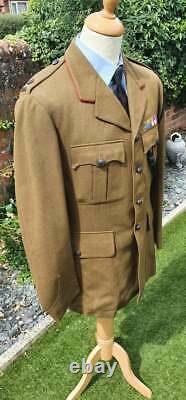
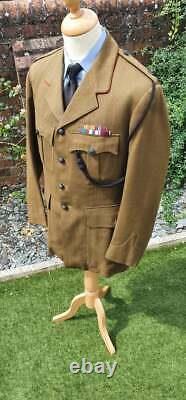
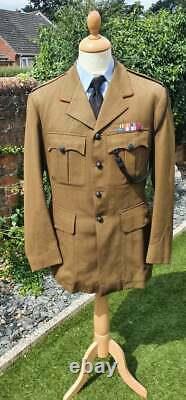
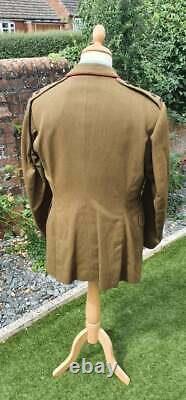
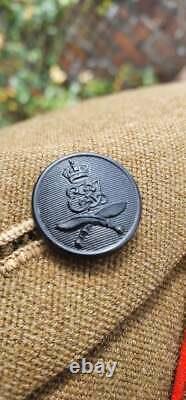
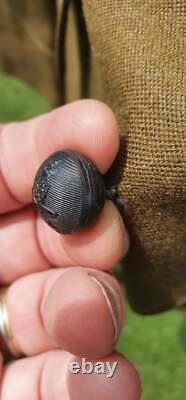


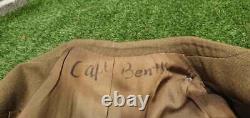
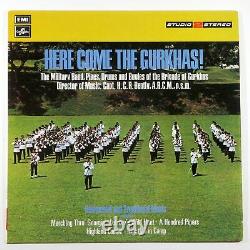
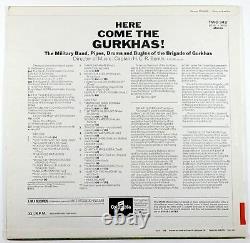

Original 2nd King Edward VII's Own Gurkha Sirmoor Rifles No2 Ceremonial Jacket No 267. Director of Music (Bandmaster) of the 2. Goorkhas from 1970 to 1981.
Bently also was accredited for his work on film and recording, with credits for. The Military Band, Pipes, Drums, and Bugles of the Brigade of Gurkhas. & also for his work on the film Tunes of Glory. This sale consists of 1 x Gurkha Jacket, in superb condition for age for age of uniform, with NO mothing, or damage that I have found. It is clean and well kept after, as you might expect.
Dark green, two pockets, tropical bush jacket. Buttons with King Edwards' initials. Both epaulettes are with 2nd Gurkha brigade. Both epaulettes are with Major insignia.Medal ribbons as show, including WW2 and General good conduct. 22 Chest- (pit to pit). 1 x pair of MATCHING Gurkha trousers, in superb condition for age for age of uniform, with NO mothing, or damage that I have found.
2nd King Edward VII's Own Gurkha Rifles (The Sirmoor Rifles). The 2nd Goorkhas was an infantry regiment of the British Indian Army before being transferred to the British Army on India?
At that time the 4th Battalion joined the Indian Army as the 5th Battalion, 8th Gurkha Rifles (Sirmoor Rifles), where it exists to this day. As part of the British Army, the Regiment served in Malaya, Hong Kong, the UK, Brunei and many other locations worldwide until 1994 when it was amalgamated with the other three British Army Gurkha infantry Regiments to form the Royal Gurkha Rifles. The 2nd King Edward VII's Own Gurkha Rifles (The Sirmoor Rifles) was a rifle regiment of the British Indian Army before being transferred to the British Army on India's independence in 1947.
The 4th Battalion joined the Indian Army as the 5th Battalion, 8th Gorkha Rifles (Sirmoor Rifles), where it exists to this day. As part of the British Army, the regiment served in Malaya, Hong Kong and Brunei until 1994 when it was amalgamated with the other three British Army Gurkha regiments to form the Royal Gurkha Rifles. It is the only Gurkha regiment which did not have a khukuri on its cap badge. The Sirmoor Rifles, Second (2nd) GR.
Green; faced and piped red, 1888 scarlet. Major General D Macintyre VC. Colonel H T Macpherson VC Subadar-Major Santbir Gurung Lieutenant-Colonel Frederick William Nicolay. The regiment was first raised in 1815 as The Sirmoor Battalion. Unit in the service of the East India Company to see action, during the. The regiment, by now named the 8th (Sirmoor) Local Battalion, gained its first. The regiment fought at Bhudaiwal and. At the time, and the flagpole was broken by cannon fire.The colour itself was seized by the. But reclaimed by a small party of Gurkhas led by a. Who chopped their way into the densely packed enemy lines. Kabul expeditionary force on the march: Quarter Guard of the.
The Sirmoor Battalion was one of the Indian regiments that remained loyal to Britain. It was during this that the regiment took part in the defence of. For their part in the action, the Sirmoor Battalion was presented with the.Which became a replacement for the colours that they relinquished when the regiment became a rifle regiment in 1858. With the decision to number the Gurkha regiments in 1861, the Sirmoor Rifles became the 2nd Gúrkha Regiment. In 1876, the battalion acquired a royal patron in the then. Becoming the 2nd (Prince of Wales's Own) Gúrkha Regiment (the Sirmoor Rifles). The 2nd Gurkhas (by now named the 2nd King Edward's Own Gurkha Rifles), along with the other regiments of the Gurkha Brigade, served initially in.
In 1915, the 2nd Battalion moved to. Before returning to India in 1916. The 1st Battalion went to. In 1916, assisting in the. In 1919 it was assigned to the. Saw the 2nd Gurkhas serving in many different theatres; the 1st Battalion was initially in. Before moving to North Africa as part of.Following this it took part in the. The 2nd Battalion meanwhile spent much of the war as prisoners of the Japanese after being captured in. The 3rd Battalion (raised during the war) took part in the. In 1947, as part of India's independence, it was agreed that the Gurkha regiments would be split between the British and Indian armies? The British Army would take on four regiments (the 2nd, 6th, 7th and 10th), while the Indian Army would retain the rest.
While the 2nd Gurkhas became one of the four Gurkha regiments to transfer to the British Army, the regiment's 4th Battalion was transferred to the Indian Army as 5th Battalion. (Sirmoor Rifles) where it exists to this day.
The first Indian commanding officer of this battalion, Lieutenant Colonel (later Brigadier) Nisi Kanta Chatterji, requested Army Headquarters, to let the battalion keep the title'Sirmoor Rifles', which was accepted. This battalion saw action in the. As part of the 3rd (Independent) Armoured Brigade, 28 and 191 Infantry Brigades where it stopped the advance of the Pakistani armour to Akhnur in the Battle of the Fatwal Ridge. The battalion now as part of the 68th Mountain Brigade, the corps reserves, once again saw fierce action in the defence of Chamb-Akhnur.It launched five successful counterattacks and recaptured the bridge over the Tawi river. It also fought in the Indian North east against the Naga insurgents and in the Doda district of Jammu and Kashmir.
Here it distinguished itself by killing the Supreme Commander of the Hizbul Mujahideen, the leading Kashmiri insurgent group. It was awarded the Northern Army Commanders Citation in 1998. It was deployed in Sierra Leone as part of UNAMSIL and distinguished itself in Operation Khukri in which the Revolutionary United Front rebels were decisively defeated. Following this, the 2nd Gurkhas spent several years in the Far East, initially during the. Following this, the regiment's two battalions alternated between.
And Hong Kong, before receiving a regimental depot at. In 1992, while serving in Hong Kong, the 1st and 2nd Battalions amalgamated to form a single 1st Battalion. This was followed in 1994 by the regiment being amalgamated with the. 6th Queen Elizabeth's Own Gurkha Rifles. To form the 1st Battalion.
The regiment was awarded the following. Pian di Maggio, Gothic Line, Coriano, Poggio San Giovanni, Monte Reggiano. North Arakan, Irrawaddy, Magwe, Sittang 1945, Point 1433, Arakan Beaches, Myebon, Tanbingon. (Bengal Staff Corps attached to the regiment)? 4 January 1872, Lalgnoora, India.
Prince Charles, Prince of Wales. KG, KT, GCB, AK, QSO, ADC. Colonels of the Regiment were. KCIE, CB, DSO, OBE, FRGS, FRSA.
Simon Patrick Martin Kent, CBE. Edwin Noel Westby Bramall, The Baron Bramall. KG, GCB, OBE, MC, KStJ. 7th Duke of Edinburgh's Own Gurkha Rifles. 10th Princess Mary's Own Gurkha Rifles.After a brief period of wearing their own indigenous clothing, the Sirmoor battalion adopted green jackets with red. These were worn with loose fitting blue trousers and a bonnet like headdress. By 1828 black facings, black leather equipment, white trousers and sandals had been issued. A variety of changes followed but the round Kilmarnock cap with red and black dicing had appeared by 1848.
While the Kilmarnock was to become common to all Gurkha regiments, the red trim was to remain a distinctive feature of the 2nd Gurkha Rifles. In 1858 links forged during the. Led to the authorization of the Gurkha regiment to adopt the red piping and facings of the British. Formally recognized as a rifle regiment since 1850 the 2nd Gurkha Regiment underwent various changes of title as recorded above. Throughout it wore the standard Gurkha parade and cold weather uniform of rifle green with leggings and then puttees, silver insignia and black metal buttons. (bobble) on the cap was to remain a distinction of the 2nd Gurkha Rifles.(initially blue/grey) hot weather dress was adopted. The broad brimmed hat was worn with khaki drill service dress from 1902 and was retained as normal uniform between the two world wars.
After World War I the historic green was limited to a few limited dress orders such as officers. And full dress for mess orderlies.
During World War II red and black patches were worn on the jungle. The item "2nd King Edward VII's Own Gurkha Sirmoor Rifles Ceremonial Jacket Tunic post WW2" is in sale since Wednesday, August 4, 2021. This item is in the category "Collectables\Militaria\Surplus/ Equipment\Clothing". The seller is "chewdo" and is located in Melton Mowbray, Leicestershire. This item can be shipped to United Kingdom, Antigua and barbuda, Austria, Belgium, Bulgaria, Croatia, Cyprus, Czech republic, Denmark, Estonia, Finland, France, Germany, Greece, Hungary, Ireland, Italy, Latvia, Lithuania, Luxembourg, Malta, Netherlands, Poland, Portugal, Romania, Slovakia, Slovenia, Spain, Sweden, Australia, United States, Bahrain, Canada, Japan, New Zealand, China, Israel, Hong Kong, Norway, Indonesia, Malaysia, Mexico, Singapore, South Korea, Switzerland, Taiwan, Thailand, Bangladesh, Belize, Bermuda, Bolivia, Barbados, Brunei darussalam, Cayman islands, Dominica, Egypt, Guernsey, Gibraltar, Guadeloupe, Grenada, French guiana, Iceland, Jersey, Jordan, Cambodia, Saint kitts and nevis, Saint lucia, Liechtenstein, Sri lanka, Macao, Monaco, Maldives, Montserrat, Martinique, Nicaragua, Oman, Pakistan, Paraguay, Reunion, Turks and caicos islands, Aruba, Saudi arabia, South africa, United arab emirates, Ukraine, Chile, Bahamas, Colombia, Costa rica, Guatemala, Honduras, Jamaica, Kuwait, Panama, Philippines, Qatar, Trinidad and tobago, Uruguay.
- Conflict: World War II (1939-1945)
- Type: Uniform/ Clothing
- Issued/ Not-Issued: Issued
- Clothing Type: Jackets
- Era: 1945-Present
- Country/ Organization: Great Britain
- Service: Army
- Country/Region of Manufacture: United Kingdom

